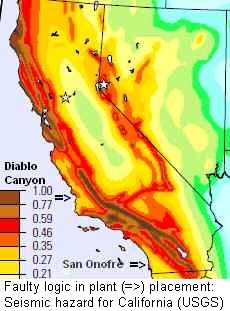The damage to plant, equipment, and infrastructure led to the shut down of several automobile plants. United States exporters will feel the impact of lower Japanese corporate revenues. China, Japan's top trading partner, may well see the loss of investment and export opportunities. In addition, China may have a new competitor for crude oil due to the disruption to Japan's overall energy supply system.
Still mired in the great stagnation since 1985, healthcare costs, rebuilding requirements, and the implosion of energy production in the Fukushima Prefecture will hit the domestic economy very hard in short order.
As if that weren't bad enough, exports faltered in January. The country showed a 500 billion Yen trade deficit for the first month of 2011, the first drop in a string of sizable surpluses since February 2009. Japan's people and economy are in for hard times. (Graph)
What if" Lessons for the United States
What would happen if a massive earthquake hit one of California's nuclear plants? California represents 13% of the US GDP, 12% of the population, and ranks number eighth in global economies. Seismic disasters are not a new phenomenon in the Golden State.
Certainly, energy companies, politicians, and regulators considered this possibility. The United States Geological Survey (USGS) produced scientific research for years fine tuning the timing, intensity, and inevitability of future earthquakes. USGS states, "the chance of having one or more magnitude 6.7 or larger earthquakes in the California area over the next 30 years is greater than 99%." The chance for a magnitude 7.5 or greater earthquake is set at 46%. (USGS)
Was anyone paying attention? Apparently not. The seismic risk map shows the danger of earthquakes for the state.
California's two nuclear power plants are located on or near major fault lines. The Diablo Canyon facility is of particular concern. Californians have been anywhere from upset to outraged at the Diablo Canyon nuclear facility from the start. More than two million people get electricity from the plant. Designed to withstand a 7.5 magnitude earthquake, there are reasons to be less than confident in this estimate. The plant operator, PG&E, completely misinterpreted blueprints in the initial construction of "certain crucial pipe supports in the reactors containment room." The misinterpretation involved constructing the pipe supports in a "mirror image" of the intended design.
Diablo Canyon is just 2.5 miles from the Hosgri Fault, a major portion of the San Andreas Fault. Construction proceeded despite the discovery of this massive fault early on.
Recently, PG&E executives diminished the importance of the Shoreline Fault less than an mile offshore from the nuclear plant. This fault was discovered in 2008. The Santa Barbara Independent reported that, "Nuclear Regulatory Commission (NRC) officials and PG&E executives have insisted there's no cause for alarm; the plant, they maintain, is designed to withstand far more force than the new fault" will generate.
The Independent interviewed USGS Chief Scientist, Tom Brocher. He noted the possibility that the Shoreline Fault runs under Diablo Canyon's reactors is "speculative" but not ruled out. Brocher said, "You're bringing into the picture the possibility that an earthquake could crack the ground surface. This would be a disaster beyond anything we've seen in Japan:
"The prospect of such a calamity -- with two nuclear reactors operating above ground and pools of spent fuels so dangerous they have to be kept submerged in water at least five years before they can be moved to steel-reinforced concrete casks -- is the stuff of nightmarish disaster scenarios." Nick Welsh, Santa Barbara Independent.
Sitting Ducks
As meltdowns and nuclear disaster continue in Japan, we should anticipate the impact of similar disasters at one or several of those red dots from the interactive global map of nuclear facilities. Natural events, plant failures, and sabotage provide an array of scenarios that can cripple a region or entire nation.
Next Page 1 | 2 | 3 | 4 | 5 | 6
(Note: You can view every article as one long page if you sign up as an Advocate Member, or higher).






